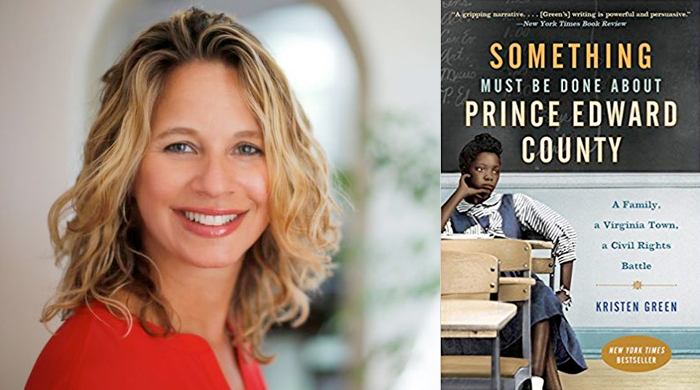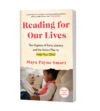Journalist Kristen Green seems born to write this particular and personal history of Prince Edward County’s legendary segregationist resolve. Yet her book, Something Must Be Done About Prince Edward County, reveals the many ways her family and community groomed her to do otherwise–to look the other way as devastating racial divides persisted.
The story of her awakening is powerful. It is rooted in history that began before her birth but is by no means past. In 1948, the all-white school board of Prince Edward County, Virginia faced overcrowding of its black schools. The board decided that seeking a bond measure for “a nigger school” was out of the question, and instead built two flimsy tar-paper shack classrooms that reeked of petroleum and leaked when it rained.
Black students went on strike in 1951, to draw attention to the deplorable conditions and demand acceptable schools. The battle quickly morphed into a desegregation movement, including a lawsuit that joined four others and went to the Supreme Court under the Brown v Board of Education banner.
The local backlash was immediate, fierce, and determined. The Supreme Court mandated public school desegregation in 1954, but the county resisted. When its actions were deemed unconstitutional, the white county leadership began underfunding the public schools and laying the groundwork for a whites-only private school called Prince Edward Academy.
Later, when given a firm deadline of desegregating by September 1959, the Prince Edward County Board of Supervisors voted to eliminate its entire education budget rather than comply. They shuttered every last one of the county’s 21 public schools and sent their own kids to the Academy, a hodgepodge of classes in churches, former homes and vacant stores, stocked with supplies pilfered from the abandoned public schools.
The county’s 1,700 black children were completely shut out, denied a free education for five hard years. That devastating loss reverberates to this day in high rates of illiteracy and poverty in the community.
Green recounts this history, as well as her personal story of coming of age in Prince Edward County, being (mis)educated at the Academy, and graduating oblivious to the harsh toll the segregationist history exacted on black residents. She bravely calls out the racism of revered figures in Farmville, the small rural town where she was reared, even of her own beloved grandfather.
The release and circumstances of this particular story of white hate and recalcitrance is perfectly timed, given recent debates over the confederate battle flag in public spaces. The depiction of Green’s earnest efforts to grapple with the past is much needed. I suspect that as a white woman, she’ll be able to reach audiences who have been deaf to these stories for years, like her former classmate, referenced in the book, who denies the racist origins of their school.
Little of the ground covered in the book is new–The Moton Museum bookshop features several accounts of the school closing, written from a black perspective–but Green’s synthesis is welcome. I’m reminded of the Daily Show parody where Jessica Williams makes points that her white colleague only acknowledges after Jon Stewart repeats them. Black people regularly tell these stories of racism, fear mongering, and hate, but many people will not really get it until a white person tells them. Such is the insidiousness of unconscious racial bias.
I’m thankful for Green and others who are bold enough to tell the truth about America’s racial hierarchy. I hope her work resonates widely. “Something Must Be Done About Prince Edward County” could actually serve as a primer for people who want to acknowledge and dismantle the racist systems they are complicit in. Her diligent efforts to ferret out the truth, correct her mistaken assumptions and educate others is instructive and worthy of wide emulation.
In particular, Green’s writing offers a couple of crucial lessons:
Go deep. When we’re honest–and informed–about our complicity with racist systems, we have a chance at redeeming ourselves. Green interviewed an array of people in the town, spent hours in dusty libraries and read book after book on the subject to grasp the complexity of the issue. She simply refused to accept surface explanations and pushed past personal discomfort to faithfully engage with the subject. She kept asking questions and cataloging responses to make personal sense of the sordid history. She pursued the truth even when it made her friends, family and herself look bad.
“It has become a painful topic for me, a source of shame and guilt,” she writes. “I feel torn between my love for my grandparents and embarrassed by their prejudice. I want to be loyal to them and protective of their legacy. Yet I believe that this story is worth exploring. My discomfort, and others’ discomfort, is all the evidence I need.”
Digging deep is the only antidote to ignorance and oversimplification. A strength of Green’s account is its depiction of a range of complicity in and reactions to the county’s turmoil. We hear from the staunch segregationists but also from the poor white farmers who couldn’t afford private school fees and the college professors who thought everyone deserved an education.
We’re not all professional journalists, so the depths of our investigations will vary. You don’t have to write a book about your discoveries, but the nation needs you to engage your critical thinking skills, weigh the evidence and come to your own conclusions–and actions.
Challenge yourself to view events from the perspective of “the other.” Green frequently uses her family’s housekeeper as the lens through which to view 60 years of Prince Edward County history. Known just as “Elsie,” she was the only black person Green knew until high school. For years, Green gave no thought to Elsie’s own family and life outside of cleaning Green’s parents’ and grandparents’ homes. Eventually, she reckoned with the incompatibility of her mom calling Elsie “part of the family” while her grandfather helped tear Elsie’s own family apart.
When the county’s public schools closed, Elsie sent her 12-year-old daughter Gwen to live with relatives in Massachusetts to get an education. Gwen stayed there for decades and Elsie, missing those formative years, never again got to be Gwen’s mother in the way she longed to be. “The separation of children from their parents echoed the indignities of slavery and the irreparable harm done when the closest of relationships were suddenly severed,” Green writes.
When taken to heart, books like this one allow empathy and action to bloom. Those who are sensitive to the suffering of others are more likely to address it.
Yes, something must be done about Prince Edward County and the rest of this nation. And, as the book reminds us, it’s up to us to do it.


